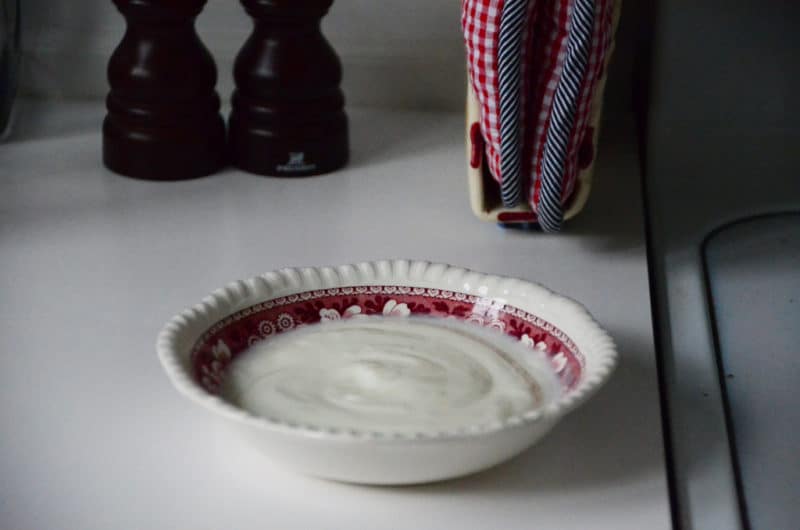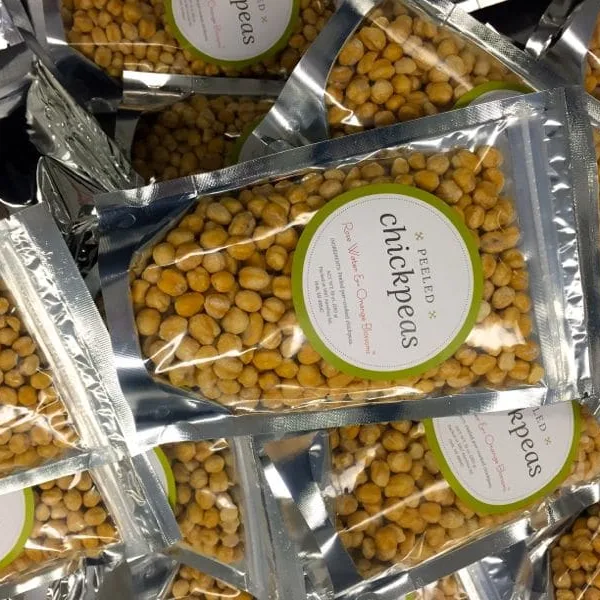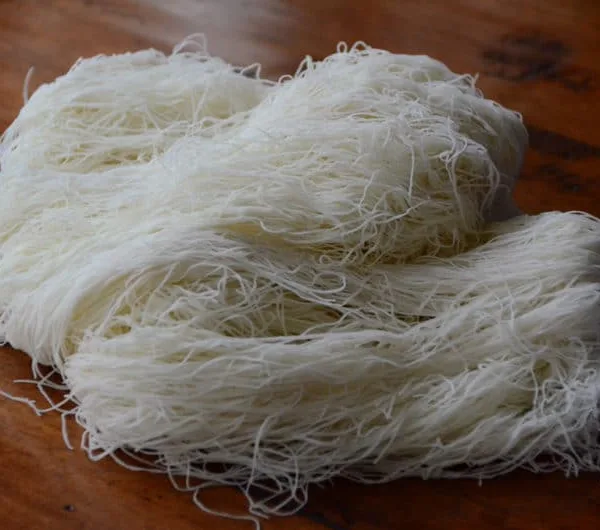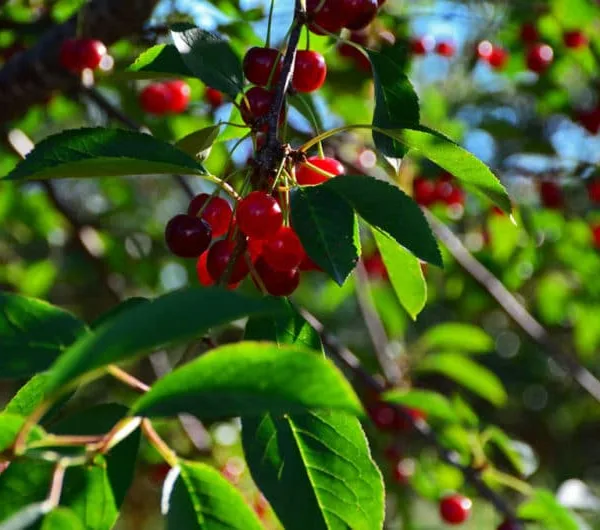This post may contain affiliate links. Please read our disclosure policy.
These tips about ingredients for homemade yogurt give us a deeper look at what makes great yogurt with complex flavor. Click over to learn How to Make Yogurt using my simple recipe with no special equipment.

Once you get the hang of making your own yogurt (a.k.a.: laban), you will do it without thinking. You’ll do it as a matter of course, the same way you start the week off with all kinds of habits. While I’ve struggled to form many a habit, laban-making is not one of them. I love having my own yogurt in the fridge so much that I make it every week. Perhaps I am addicted to the kitchen-thrill of discovering each time that yes, my milk has set, and yogurt has been born.
Making yogurt this frequently also means I can make a smaller batch at a time. When I tried to make a huge batch not that long ago for a dinner for the poet Naomi Shihab Nye, things got out of hand. I bought three gallons of milk and used two large pots, neither of which was very heavy or equipped for the task.
Apparently I wasn’t either, because Murphy’s law was at play that day. The large amount of milk heated at a snail’s pace, and I got distracted. The milk boiled over, which is a major event to clean up on the pain-in-the-neck flat electric cook top we have on Main Street. I recovered from that and did end up with laban after its overnight rest, but then when I was about two hours into my trip downstate for the event, I remembered my big pots of laban were still back in Harbor Springs, in the refrigerator. Which turned out to be a good thing, because when I arrived up north again and pulled out the laban, it smelled and tasted distinctly of bonfire. I love a good smokey bonfire flavor all over my marshmallows, but not my laban. Suffice it to say I’m a fan of the small-batch laban. Hand-crafted, as they say.

Let’s cut to the chase before I launch into a lengthy story about yogurt and its deep culinary history and meaning in my family and probably yours too. I know many of you have also made a lot of laban in your time, so by all means please weigh in on your own tips. In addition to the tips below, click over for my method and recipe for How to Make Yogurt.
Here are my tips about ingredients that are helpful when making your own yogurt at home:
- The milk. I always use organic milk, because anything I eat that much of, I like it to be as clean as possible. Yogurt can be made with skim, 1%, 2%, or whole milk. Of course, whole milk is the best in terms of flavor and texture. Heck, I’ve even taken a page out of Aunt Hilda’s play book and poured in a pint of heavy cream with my milk. Good Lord, that’s like the wedding gown of all laban—some seriously luscious, special-occasion loveliness.
- The starter. Yogurt is made like sourdough, with a starter—called “rawbi” in Arabic—from your last batch. If you have no last batch, use yogurt from the store. Much of your yogurt-making success depends upon the starter. Just ask Amara, who discovered after three exacting tries last week that it must be a faulty starter she was working from. She changed that up, and voila!, she had laban.If you buy commercial yogurt for your starter, be sure it’s plain (not vanilla). I generally use a whole milk (not non-fat) rawbi, even if I’m making a low-fat laban with low-fat milk. Thicker labneh or plain “Greek” yogurt can work for rawbi, but I’ve experienced fails with that once or twice, and that’s what was causing Amara’s trouble as well. I tend to stick with regular, unstrained (thinner) yogurt. The starter should be room temperature when it’s stirred into the milk, so let it sit out for a while before you make your yogurt, or warm it in the microwave for a few seconds. You’ll “temper” the starter (bring it to similar temperature as the milk) with a little warm milk from the pot as well.
- The flavor. Yogurt is made with such simplicity, and so few ingredients, that it is going to taste only as good as your ingredients. The Lebanese enjoy their yogurt with a certain tang, a certain depth of flavor that is unlike the typical sweetened or plain commercial yogurt. Commercial Greek yogurts sometimes capture this flavor (whole milk Fage comes darn close). When my homemade yogurt lacks depth of flavor, I add lemon juice to the starter (just a squeeze), then salt it a bit and leave it out on the counter for the day and it ferments some. I add more lemon juice when the yogurt is made for more tang, as needed. Or I try to find a starter that has better flavor for my next batch, from someone else’s laban or from the homemade laban you can purchase at Middle Eastern markets. Authentic Lebanese laban is often made with goat’s milk, which is super flavorful, rich, and good.
Recipes with Yogurt
Lebanese favorites use yogurt as a broth, a sauce-style base for soups such as Kibbeh in Yogurt Sauce, Kibbeh bi Laban and Koosa in Yogurt Sauce.
Try these traditional, delectable meat-filled dumplings cooked in yogurt, Lebanese Shish Barak.
Yogurt works as a wonderful ingredient in baking. Check out my Recipes for Baking with Yogurt.











Hi Maureen,
I love your cookbook and reading your blogs! It reminds me so much of my Sitto…..she taught me how to make grape leaves and laban. I grew up in the Detroit area and still live in Michigan. Although my parents and grandparents are no longer alive, it’s so great to reminisce about the wonderful cooking that my Sitto did through your writing.
One question about the yogurt starter or rabbi – when do I take this from my laban to use for my next batch? I assume it’s before it’s strained but not sure? Thanks so much.
Kathy Tomey
Hi Kathy–thank you so much; I love hearing all of that. For the laban, I use laban or strained labneh with success, either way. But for whatever reason I prefer to use the unstrained laban.
Hi Maureen,
My mother in law adds some water to the starter. She says this makes the yoghurt less sour. I don’t know if there is any truth to this but her yoghurt comes out amazing! Like perfectly set with no water or crust on top!
Love your recipe, I have been impressing my Lebanese family with my Laban for years now. Thanks so much!
Fascinating! I love these sorts of tips.
Hi Maureeen in Cyprus the most authentic yoghurt is made in villages in round clay pots, using Ewes milk(sheep) or goats milk…. although Commercial yog is also made, let me tell you , there is no comparison to that of village yoghurt … creamy aromatic tangy deliciousness with a lovely (thin crinkley skin on top,)which I always scoop into spoon carefully and eat ,my favourite !
As for another specialty, yoghurt with walnuts and thyme honey
Or carob syrup… yum
It all comes down to what the sheep – goats graze on; usually wild herbs ,thyme ,grasses,
That sounds amazing and special and wonderful Mairia!
I noticed someone asked about raw milk. Of course it can be made with raw milk. That’s all they had for thousands of years. And all we had when I was young. Daisy and Princess , our milk cows, didn’t process the milk. 🙂
I’ve been making Middle Eastern style yogurt for 16 years. I make it weekly, on the stove top with 2L milk and a 2-qt saucepan, plus a 24 hour rest in the oven with the light on (the longer rest is for my preferred acidic taste). In the last few months, I’ve purchased an Instant Pot, an electric pressure cooker which also functions as a yogurt maker. It heats the milk to 190F without fear of spillage (that cooktop clean up is a major pain) and incubates the yogurt right in the pot itself (no more planning my cookie baking schedule around my long-incubated yogurt). This contraption can handle up to 4.5L milk at a time. Cheers!
Wow, how great! Sounds like a great yogurt maker.
When I first learned to make Laban, I was in college, junior year. My cousin Andrea was staying with me so we called Sitti for the directions. Identical to yours I might add. So it came time to do the pinky count, Andrea volunteered. That night — no yogurt just liquid. We called Sitti and she said, “Let me speak to Andrea”. She asked her if she was on her period; she was. Sitti said it won’t come out if your having your cycle and put your finger in the milk!! Thought it was crazy and we’ve proven it over and over!!
Crazy!
I remember when my mother and grandmother would cook the milk on the stove just as you have described. Then came the MICROWAVE! My mom was reluctant to buck tradition but she did concede to cooking the milk in the microwave. It simplifies the process 100%!!
Pour milk in large glass bowl. Don’t try to make more than 1/2 gallon. Cook until you see the thick layer bubble on top (about 17-20 minutes for 1/2 gallon) No need to stir or interrupt the cooking. Remove from microwave, use a thermometer and bring temperature down to 125-130. Temper your starter with the warm milk, then stir in to the bowl of cooked milk. Stir well, cover and put back in your microwave or any warm place for about 8 to 10 hours. (I usually make in the evening and leave in microwave or oven overnight.
Love this Jean Ann, thank you!
Have you ever made laban with raw milk?
I just got some rawbi from a friend whose husband is Syrian. His family brought it with them when they immigrated to the states. It’s still in the family! How cool is that? When she was explaining how she made hers, it followed your instructions to the letter – even the pinkie test! I’m making your recipe right now. Keep your fingers crossed for me. Your posts are great. Thanks.
That is SO cool Patty…please let me know how the raw milk does for laban. My guess is that it’ll be absolutely delicious!
I used to make my own yogurt, but haven’t for years. That was before becoming a vegetarian…can I use Almond Milk?
Hi Judie, and thank you–I have not made yogurt with almond milk, but read about it here.
When you make Laban and it does not turn out what do you do with the leftovers? I read once you could reheat the milk and add more starter and just try it again. Not sure this true. I just hate to waste organic milk.
That’s true, Rhonda! You can start the process over and use your failed batch to make the laban again.
Love your description of our traditional, wonderful Laban. I thought it was our special “thing”. I was told we have a mountain in Lebanon with snow on the top….hence our Laban is special because of that. Yes….pinky testing is a must. It makes me smile, but, honestly, it works! Thank you Maureen….you are so very, very good with your recipes…..keep it up!
Lenore thank you so much! Yes, I too have read and heard the ‘laban’ is for the white topped mountains. Very special in any case!
When I just made the yogurt at my Mom’s it came out great!! But like you, my Mom mentioned that sometimes it just doesn’t turn out.
I am so glad to now know how to make my own yogurt and not rely on buying the stuff from the store (especially since my one year old loves yogurt). I have grown up eating the plain stuff..I love it mixed in with salads or alongside my kibbeh and pita.
I have always wondered how to get the kick that grandma’s laban and labne had. I will try your method of leaving it out a bit.
I also like to salt and a touch of olive oil and Zahtar with labne for a taste spread.
I love to read you as I hear your voice and laugh as you talked about the smoky yogurt!!!
I cannot wait to make my own yogurt.
I’ve been wanting to for years…here we go!